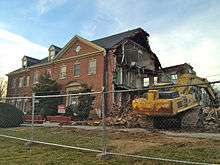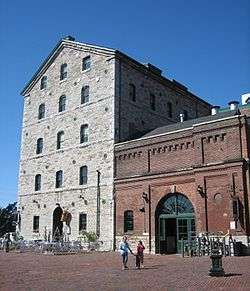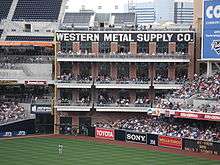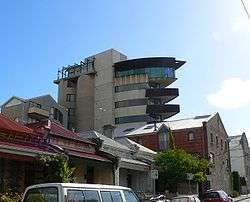Adaptive reuse

Adaptive reuse refers to the process of reusing an old site or building for a purpose other than which it was built or designed for. Along with brownfield reclamation, adaptive reuse is seen by many as a key factor in land conservation and the reduction of urban sprawl. However adaptive reuse can become controversial as there is sometimes a blurred line between renovation, facadism and adaptive reuse. It can be regarded as a compromise between historic preservation and demolition.
Definition
Adaptive reuse deals with the issues of conservation and heritage policies. Whilst old buildings become unsuitable for their programmatic requirements, as progress in technology, politics and economics moves faster than the built environment, adaptive reuse comes in as a sustainable option for the reclamation of sites. In many situations, the types of buildings most likely to become subjects of adaptive reuse include: industrial buildings, as cities become gentrified and the process of manufacture moves away from city; political buildings, such as palaces and buildings which cannot support current and future visitors of the site; and community buildings such as churches or schools where the use has changed over time.
Adaptive reuse is seen as an effective way of reducing urban sprawl and environmental impact.[1] By reusing an existing structure within a site, the energy required to create these spaces is lessened, as is the material waste that comes from destroying old sites and rebuilding using new materials. Through adaptive reuse old, unoccupied buildings can become suitable sites for many different types of use.
Factors affecting adaptive reuse
Criteria for adaptive reuse
While the process of adaptive reuse is a decision often made purely by companies establishing a particular brand or presence, there are often criteria for deciding whether a building should be conserved and reused or just demolished for the area of land it occupies. Some of these determining criteria include:
- The societal value of a given site; that is, the importance to the community of the use of a site by community members or visitors.
- The potential for the reuse of a particular site; the physical damage sustained to the site and its support of future use, the character of the existing site in terms of the proposed reuse.
- The historical importance of the site; in terms of both the physicality of the street-scape and the area, as well as of the role of the site in the community's understanding of the past.
- The environmental conditions of the site; whether the site is suitable climatically or can support the proposed environmental work needed in the site.
Economic considerations

There has been much debate on the economic possibilities and viability of adaptive reuse as different corporations and companies seek to find sustainable ways to approach their corporate or retail sites.[2] There are many outcomes that affect the economic return of adaptive reuse as an avenue to reuse of a given site. Factors such as the reuse of materials and resources as well as a lesser need to involve energy, both in terms of labor and machine powered, can effectively decrease the monetary funds needed for companies to establish sites. However, there can be hidden costs in reusing old buildings such as the unknown contamination of older sites, decay and disuse affecting the usability of a building, and the possible need for modification of an older building to fit current and future building codes.[3]
The economic costs differ from project to project and some professionals go as far as to assert that new build is always more economical and renovation is universally more expensive,[4] due to their own involvement with adaptive reuse projects. Others claim that the return on investment is enhanced when using an older building because of the savings involved. One Canadian developer claims that reusing buildings generally represents a saving of between 10-12%[3] over building new. In terms of profitability, there are also assertions that adaptive reuse projects often have an uncertainty to their profitably that newer developments lack. When looking for funding to build, these considerations must be addressed.
With many heritage sites on the agenda for government agencies, there are a number of financial incentives provided in order to increase the use of older sites in many countries. In the provinces of Canada, some municipalities offer financial encouragement for heritage development such as, the City of Waterloo who waived the development charges for the Seagram Lofts that have been estimated to be around $700,000.[3] Governing bodies also benefit from the reuse of once abandoned sites as once occupied, they generate tax revenue and therefore often recover the initial investment.
Advantages of adaptive reuse
With the debate of adaptive reuse as a sustainable avenue in the development of key sites, there are many advantages to using certain sites for redevelopment. One of these advantages is the site's location. In many cases, historical sites are often located in the centers of large cities. Due to the spatial development of a given area, these buildings can often be heritage-listed and therefore sold as an entity, rather than just for the land that they occupy, which the new tenants then have to retrofit the building for their particular purpose. Older buildings also often have a specific period character through the detailing and joinery of their constructed eras that newer or reconstructed developments lack. In certain cases such as the hospitality industry, the grand character of a site can influence the feel of their building and are used for maximum potential to enhance the site's physical attractiveness to a client.
Barriers to adaptive reuse
As mentioned above, adaptive reuse sometimes isn’t the most viable option for all historic sites. For some sites that have been left alone to decay by neglect, the physical damage of the site can render the site unusable both in terms of the cost to repair the damage as well as unsafe by government standards. Adaptive reuse of sites contaminated by hazardous materials such as asbestos also require special precautions during construction, although these procedures are well-established. See, for example, http://www.labor.state.ny.us/workerprotection/safetyhealth/sh56.shtm
By location
Americas
Canada
As a comparatively young country, adaptive reuse is not the norm in Canada, where redevelopment has typically meant demolition and building anew. Calgary and Edmonton are particularly known for their pro-demolition culture, but they are not unique in this regard.[5][6] However, since the 1990s, adaptive use has gained traction. The conversion of former railway-centred warehouse districts to residential and commercial uses has occurred in Edmonton, Calgary, Saskatoon, Regina, and Winnipeg.

In Toronto, the Distillery District, a neighbourhood in the city's southeast side, was entirely adapted from the old Gooderham & Worts distillery. Other prominent re-uses include the Candy Factory on Queen Street West and the Toy Factory, in the city's Liberty Village district, both designed by Quadrangle Architects, a firm specializing in adaptive re-use in Toronto and elsewhere. Vancouver's Yaletown, an upscale neighbourhood established in the 1990s, features warehouses and other small-industrial structures and spaces converted into apartments and offices for the gentrification of the area. Vancouver's Granville Island also demonstrates a successful mix of adaptive reuse as well as retention of traditional uses in the same district. Montreal's Griffintown, Old Port, and Lachine Canal areas all feature ex-industrial areas that have been reused or will do so in the future on current plans.
Other noted adaptive reuse projects in the 2010s have included the Laurentian School of Architecture in Sudbury, which is incorporating several historic buildings in the city's downtown core into its new campus, similar to the downtown campus of NSCAD University in Halifax, and Mill Square in Sault Ste. Marie, an ongoing project to convert the derelict St. Mary's Paper mill into a mixed-use cultural and tourism hub.[7]
A number of former military bases in Canada, declared surplus in the 1990s, have also proven to be opportune for adaptive reuse. An example is the former CFB Cornwallis in rural Nova Scotia which was largely converted, without demolitions, into a business park.
United States

Ghirardelli Square in San Francisco was the first major adaptive reuse project in the United States, opening in 1964. Urban waterfronts, historically used as points for industrial production and transport, are now selling-points for home buyers and renters. In American city neighborhoods that have seen racial and ethnic demographic changes over the last century, some houses of worship have been converted for other religions, and some others have been converted into residences.
A large number of brick mill buildings in the Northeast United States have undergone mill conversion projects. In the United States, especially in the Northeast and Midwest, loft housing is one prominent result of adaptive reuse projects. Formerly-industrial areas such as the Meatpacking District in New York City, Callowhill in Philadelphia and SoMa in San Francisco are being transformed into residential neighborhoods through this process. This transformation is sometimes associated with gentrification. Station Square in Pittsburgh Pennsylvania is an example of a mile-long former Pittsburgh and Lake Erie Railroad terminal and headquarters being converted into a retail, office, hotel, and tourist destination. The Pratt Street Power Plant in Baltimore was converted to offices, retail, and restaurants. An example of adaptive reuse conversion to office space are The Hilliard Mills. The adaptive reuse of Empire Stores will transform seven abandoned coffee warehouse in Brooklyn Bridge Park in New York City into office, retail, restaurant and a rooftop public park.[8][9]
Other museums adapted from old factories include "MassMOCA", the Massachusetts Museum of Contemporary Art, the Watermill Center in Long Island, New York, and The Dia Art Foundation Museum in upstate New York.
In San Diego, California, the historic brick structure of the Western Metal Supply Co. building at 7th Avenue (between K and L Streets) was preserved and incorporated into the design of Petco Park, the new baseball-only ballpark of the San Diego Padres, and can be prominently seen in the left-field corner of that ballpark. It now houses the team's flagship gift shop, luxury rental suites, a restaurant and rooftop bleachers, and its southeast corner serves as the ballpark's left field foul pole.

Australia
In Australia, there have been a number of adaptive reuse projects as the main cites have turned from industrial areas into areas of high value and business areas. In Sydney, sites such as the old Sydney Mint have been renovated and adapted into inner-city headquarters for the Historic Houses Trust of New South Wales. The movement of the city from an industrial, working class area into a gentrified area with high house prices has helped a number of adaptive reuse sites to exist within such an area, the old Hyde Park Barracks building has also been transformed from an old jail into a museum which documents and records the history of Australia's first settlers and convicts.
The industrial history of Australia has also been an influencing factor in determining the types of buildings and areas which have gone on to become adaptive reuse sites, especially in the realms of private residences and community based buildings. Some such sites include, Nonda Katsalidis’ Malthouse apartments in Richmond, a conversion of a former grain silo and the South Australian site of the Balhannah Mines which was adapted into a private residence and has received awards from the Housing Industry Association and the Design Institute of Australia.[10]
In Adelaide four prominent, heritage listed 19th Century buildings in poor repair were restored, refurbished and given new roles by the South Australian Government during the Rann Government (2002 to 2011). The Torrens Building in Victoria Square, former headquarters of the Registrar-General, was restored and adapted to become the Australian campus for both and University College London.[11] The former Adelaide Stock Exchange building was purchased, restored and adapted to become the Science Exchange for the Royal Institution Australia and the Australian Science Media Centre.[12] The Torrens Parade Ground and building were restored for use as a headquarters for veterans' organisations.[13] Nearly $50 million was committed to restore and adapt the large Glenside Psychiatric Hospital and precinct as the new Adelaide Studios of the South Australian Film Corporation opened by Premier Rann in October 2011.[14] And the 62 hectare former Mitsubishi Motors plant is being adapted to become a clean manufacturing centre and education and training hub for Flinders University and TAFE.[15]
Europe
In Europe, the main forms of adaptive reuse have been around former palaces and unused residences of the different European royal families into publicly accessible galleries and museums. Many of the spaces have been restored with period finishes and display different collections of art, and design. In Paris, France, the most famous example of adaptive reuse is the Musée du Louvre, a former palace built in the late 12th century under Philip II and opened to the public as a museum in 1793. Also, in London, England, the Queen's House, a former royal residence built around 1614, has become part of the National Maritime Museum and houses the museum's fine art collection.

The Tate Modern, also in London is another example of adaptive reuse in the European continent, unlike other adaptive reuse galleries in Europe, the Tate Modern takes full advantage of the site of the former Bankside Power Station, which involved the refurbishment of the old, abandoned power station. The wide industrial space has proven to be a worthy backdrop to modern art, with the famous turbine hall hosting artists including Olafur Eliasson, Rachel Whiteread and Ai Weiwei.
Other famous adaptive reuse sites in Europe include the Maastricht branch of the Selexyz chain in the Netherlands. This project received 2007 Lensvelt de Architect interior design award for its innovative reuse and is number one on The Guardian's worldwide top ten bookstores list.[16]
See also
- Architectural conservation
- Art conservation and restoration
- Facadism
- Historic preservation
- Mill conversion
- World Heritage Sites
- How Buildings Learn
Notes
- ↑ Joachim, M. 2002, Adaptive reuse, Massachusetts Institute of Technology, Cambridge, Massachusetts, 1 Oct. 2011 <http://www.archinode.com/lcaadapt.html>
- ↑ Hyllegard, K., Paff Ogle, J., Dunbar, B. 2003 ‘Sustainability and Historic Preservation in Retail Design: Integrating Design into a Model of the REI Denver Decision-Making Process’ Journal of Interior Design Vol. 29, No.1&2, pp. 32-49
- 1 2 3 Shipley, R., Utz, S., Parsons, M. 2006 ‘Does Adaptive reuse Pay? A Study of the Business of Building Renovation in Ontario, Canada’, International Journal of Heritage Studies Vol. 12, No. 6, pp. 505–520
- ↑ Blackburn, L. 1983 ‘What Developers Think of Historic Preservation’ Urban Land Vol.42, pp. 8 – 11
- ↑ Will Ferguson – Sandstone City. Willferguson.ca (2002-10-07). Retrieved on 2013-12-06.
- ↑ Photo Collections | Edmonton Public Library Archived 2 July 2013 at the Wayback Machine.. Epl.ca. Retrieved on 2013-12-06.
- ↑ "Designers hired for Sault redevelopment project". Northern Ontario Business, 15 May 2014.
- ↑ "Midtown Equities to Redevelop Empire Stores and St. Ann's Warehouse to Develop Tobacco Warehouse at Brooklyn Bridge Park". www.mikebloomberg.com. 4 September 2013. Retrieved 5 December 2013.
- ↑ Dunlap, David (25 September 2013). "Another Pass at Revitalizing Abandoned Warehouse Space on the Waterfront". The New York Times. Retrieved 5 December 2013.
- ↑ Australian Government Department of the Environment and Heritage 2004, "Adaptive reuse – Preserving our past", DEH, Canberra
- ↑ Carnegie Mellon University
- ↑ Williamson, Brett (14 June 2016). "Iconic buildings of Adelaide: Come inside the Stock Exchange". 891 ABC Adelaide. Retrieved 20 October 2016.
- ↑ Cabinet Documents, Department of Premier and Cabinet, July 2002
- ↑ South Australian Film Corporation
- ↑ Sydney Morning Herald,28 May 2011. Gary Hitchens, "Rann vision shows the way in economic renewal"
- ↑ Dodson, S. 2008, Top shelves, The Guardian, London, UK viewed 1 October 2011< http://www.guardian.co.uk/books/2008/jan/11/bestukbookshops>
External links and further reading
- Rhode Island School of Design – graduate program on adaptive reuse
- On Adaptive Reuse A blog, mostly architectural, but it also treats adaptive reuse as an approach to a wide range issues.
- "Adaptive Re-Use of Brownfields: A Challenge for the Valuation," John A. Kilpatrick
- Adaptive Reuse Photo Gallery Adaptive reuse building example and photo gallery (Evanston, Illinois)
- Pettinari, J. 1980, ‘Adaptive Reuse: A Case Study’, Journal of Interior Design and Research, Vol. 6, No. 2, pp. 33–42
- Bullen, P., Love, P. 2011, ‘Factors influencing the adaptive re-use of buildings’, Journal of Engineering, Design and Technology Vol. 9 No. 1, pp. 32–46